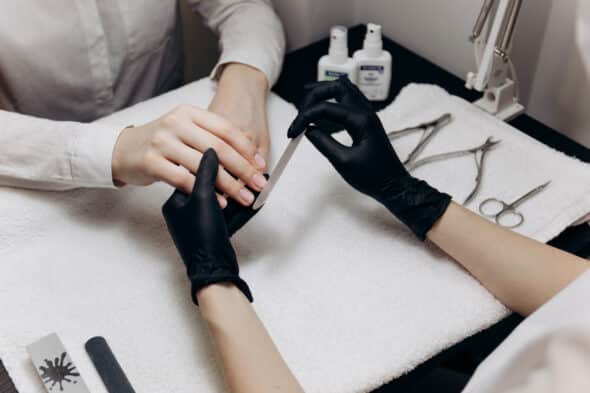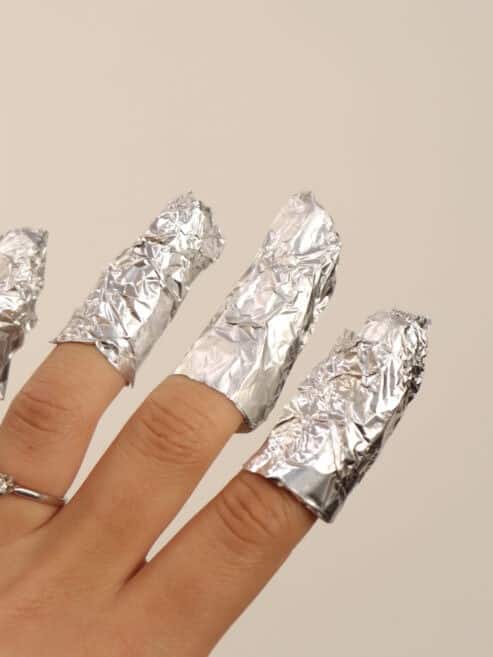Gel Polish Removal
Gel polish, commonly used in popular manicure techniques, can be quite challenging to remove. Finding the right way to remove this material without damaging your nails is a common concern among those who appreciate its super-strong coating.
You can find numerous tips online on how to remove gel polish at home. While it's certainly possible to do it yourself with some practice, it often ends up causing more harm than good to your nails.
At our salon, we offer a quick and nail-friendly professional gel polish removal service using specialized equipment.
Types of Professional Gel Polish Removal
Currently, there are two main methods for removing gel polish: acetone dissolving and machine-assisted (using a special drill). Each method has its own advantages and disadvantages. Let's go through both procedures step by step.

Acetone Dissolving
Removing gel polish with an acetone-based solvent is more complicated than removing regular nail polish. Gel polish needs to be softened. A cotton pad soaked in the solvent is applied to each nail, and then each finger is wrapped in foil and left for 10-15 minutes. Some professionals use special plastic caps instead of foil to secure the cotton pads, preventing them from slipping.
Afterward, the softened gel polish is gently removed by the master, and the nails are treated with oil after filing and buffing. However, there's one drawback: due to prolonged contact with the acetone, skin irritation, redness, and discomfort can often occur.

Machine-Assisted Method
This method can only be performed by an experienced master. Initially, the process with a buzzing drill may cause apprehension and unpleasant associations with a dental drill. However, with high-quality equipment, such as a powerful milling machine and an integrated vacuum cleaner, the gel polish removal from all nails takes no more than 15 minutes.

Combined Method
Because the above-mentioned gel polish removal methods have their noticeable drawbacks, experienced professionals often use a combined method, which includes the following steps:
- Grinding off the top layer with milling attachments.
- Dissolving or removing the lower layer with a gentler attachment (in case of acetone intolerance).
With this approach, the risk of damaging the nail plate is minimal. Nevertheless, it's important to remember that, for the health of your nails, you shouldn't change your gel polish too frequently. The recommendation from our salon's experts is not more than once a month. This way, your hands will always look well-groomed and beautiful.
Customer reviews
-
I adore PDP. I especially like hairdresser Yana who works in a salon located on Shota Rustaveli Street. After her great work my hair looks stunning and shiny. This is the best salon for me in all respects. There is always a cool atmosphere and friendly beauty experts.
-
I like styling and makeup in PDP. There is always a great atmosphere, I feel as at home. I also get a lot of compliments concerning my styling and makeup on different events. Of course, I always recommend PIED-DE-POULE beauty salon to all of my friends.
-
I have been regularly visiting PIED-DE-POULE for BRAE hair care for more than a year. Thanks to this procedure I grew health dreamed length of hair. I do styling more often than care. I like that different beauty experts work with me but I always get the same professional services.
-
I have been visiting this lovely beauty salon for a year already and I am extremely satisfied with service quality. These are the procedures I do on a regular basis! All the specialists always follow my requests! I especially adore a beauty expert whose name’s Maxim. He is just wonderful specialist! I am extremely thankful for the service quality.
-
I wish to express my gratitude to PIED-DE-POULE! The staff took into account all my wishes concerning the choice of hair color. The result was just wonderful! Also, I had a facial peeling and pedicure – all in all, I liked the service!
-
I have been a regular customer of the network of PIED-DE-POULE beauty salons for more than two years. I visit PDP on Shota Rustaveli most often as far as its location is convenient for me. Additionally, my favorite makeup artist, Ira, works there.
-
I visited PDP for the Balmain hair treatment (we tried to solve the problem of dry hair after lighting into blonde). Hairdresser’s name is Iia. She has told me about hair care and helped me to choose right products for my hair. I am really satisfied with her work. This “ritual” is my chance to grow length again after being blonde and having a bob).
-
PIED-DE-POULE beauty salon has been one of my favorite places in Kyiv for many years. I always choose and visit only this salon and I do not go to other places. There is always friendly atmosphere and professionalism of high-level. What is more, there is one significant point: if you come to PDP and you are hungry, the staff can offer you a menu with delicious and healthy food which can be delivered really fast!
-
I have been visiting PIED-DE-POULE for two years already and I am thrilled with the quality of the procedures, all the staff and communication. I like the possibility to always choose the most suitable time for me. Also, thanks to the salon, I never miss any new product of beauty industry and especially products for hair care as far as I enjoy them much!